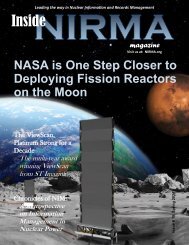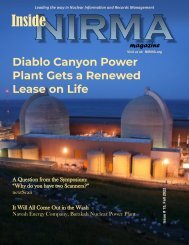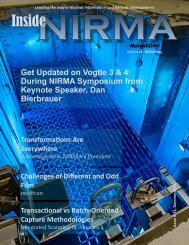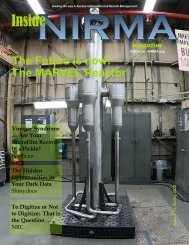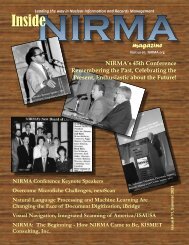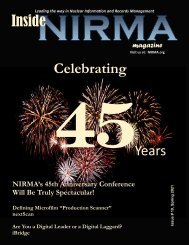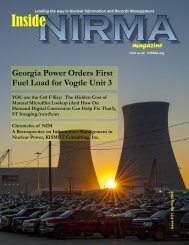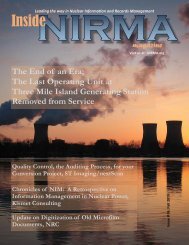Summer Inside NIRMA Issue
You also want an ePaper? Increase the reach of your titles
YUMPU automatically turns print PDFs into web optimized ePapers that Google loves.
By Eugene Y. Yang,<br />
Principal Consultant<br />
KISMET Consulting, Inc.<br />
There are two key aspects of managing electronic records that I’ve mused<br />
about for a while: retention and disposition. I’m not sure of the<br />
understanding on the ramifications of long-term storage, and then “what<br />
happens” when “time is up”? I’ll be sharing my thoughts in a two-part series<br />
linking electronic records retention with electronic records destruction.<br />
Here’s Part 1.<br />
a<br />
PART 1: RETENTION OF ELECTRONIC OBJECTS<br />
nuclear facility’s quality assurance program is<br />
governed by 10 CFR 50, Appendix B, “Quality<br />
Assurance Criteria for Nuclear Power Plants and<br />
Fuel Reprocessing Plants,” and implemented by the<br />
facility through standards compliance to either ANSI<br />
N45.2, “Quality Assurance Program Requirements for<br />
Nuclear Facilities” or ASME NQA-1, “Quality<br />
Assurance for Nuclear Facilities”. In both these<br />
standards, there are various types of information listed<br />
that document assurance with general retentions of<br />
“lifetime” and “nonpermanent”.<br />
Hmm. Bear with my musings…<br />
In the “lifetime” determination, most nuclear facilities<br />
use the event-driven retention of “life of plant”. When<br />
the first plants started up, “life of plant” was seen as<br />
being 25-30 years down the road; newer plants are being<br />
licensed to operate for 40 years. Through license<br />
renewal, plants are having the “life of plant” extended<br />
an additional 20 years; there are some plants that are<br />
contemplating getting another license renewal, which<br />
may extend the operating life yet another 20 years.<br />
When the “cease operations” decision does come, and<br />
decommissioning commences immediately, such a<br />
project will typically take an additional 10 years.<br />
(SAFSTOR, however, may place a plant in hiatus for<br />
“n” number of years before decommissioning can take<br />
place). And, because the issue of a permanent highlevel<br />
radioactive waste (HLW) repository hasn’t been<br />
resolved, plants moved to storing spent fuel and other<br />
HLW in dry casks on site. Therefore, an NRC license<br />
needs to be maintained to store that nuclear material.<br />
Finally, certain records are subject to retention<br />
requirements called out by American Nuclear Insurers,<br />
which dictate that those records be kept for life of plant<br />
plus an additional 10 years.<br />
“Life of plant” is subjective ...<br />
so, a quality record created at the<br />
beginning of plant’s lifecycle, and<br />
deemed to be kept for life of plant ...,<br />
could be, maintained for upwards of<br />
100-120 years.<br />
“Life of plant” is subjective (is it when operations<br />
cease? end of decommissioning? license termination?);<br />
so, a quality record created at the beginning of plant’s<br />
lifecycle, and deemed to be kept for life of plant (started<br />
in hardcopy, but scanned in later – more on that later),<br />
Continued on page 24.<br />
Back to Content | <strong>Inside</strong> <strong>NIRMA</strong> <strong>NIRMA</strong>.org <strong>Summer</strong> 2024 23



